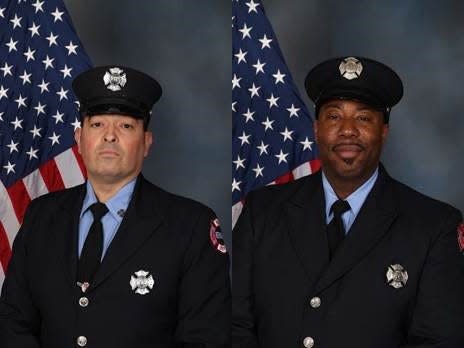Ship fire that left two Newark firefighters dead expected to burn for days
The Newark cargo ship fire that killed two firefighters on Wednesday night is expected to continue burning for days, according to Thomas Wiker, president of Gallagher Marine Systems, which is representing the ship owner.
Augusto Acabou, 45, and Wayne Brooks Jr., 49, both Newark firefighters, were found dead on the ship, the Grande Costa D'Avorio, authorities said.
Firefighters are unable to access many of the decks and cars burning due to the extreme heat. Though the vessel is currently stable, there are concerns that parts of the steel structure could collapse. The vessel is currently tilted due to excess water from fire hoses and fireboats. Fire teams are dewatering the vessel to prevent the ship from further tipping.
“At this point, the fire is going to burn for a couple of more days, probably,” Wiker said. “It’s impossible to give … any kind of definitive timeline.”
None of the officials present at a Friday press conference in Elizabeth was able to speak to why first responders were inside the ship on Wednesday night. Officials do not know the cause of the fire and are planning to investigate after it has been extinguished.
There are a variety of fires burning among several decks in the superstructure. The decks and cars that are burning are inaccessible to the fire teams because of the extreme heat within the steel vessel, making the fire difficult to fight, said Gordon Lorenson, a project manager for Donjon Marine Co. who is helping fight the fire.
A team of more than 20 firefighters and additional salvage support has been constantly fighting the fire since it began on Wednesday night. Fireboats are also helping combat the blaze while nine more firefighters joined the response team Friday.
The fire team is focused on protecting the safety of first responders and containing the fire on board. The team is cooling the vessel from the perimeter using fireboats and hoses in order to prevent the fire from spreading.
Although the vessel is currently stable, there are concerns that decks on the boat could collapse and that the ship could tip further due to the water from the fire pumps weighing on the vessel. Fire teams are working on restoring the ship to an even keel through dewatering the ship.
“There are structural issues always caused by fire within a steel vessel,” Lorenson said. “So, we are monitoring that at all times and making sure that we don’t put any people in the vessel that could be harmed by any collapse.”
Training for fires on ships
The Newark Fire Department was the first to arrive at the scene on Wednesday and it remains unclear if its members were trained to handle cargo ship fires. Both the Port Authority of New York and New Jersey and the Coast Guard have task forces dedicated to training firefighters on marine firefighting resources, in addition to efforts at the local, county and state levels, according to Capt. Zeita Merchant, commander of the U.S. Coast Guard Sector New York. Officials have not directly addressed when the Newark Fire Department last received any training on marine firefighting.
"Shipboard fires are very unique," Lorenson said. "They're constantly changing. Every single one is different. You could do all the training in the world and you're going to find something you've never seen before on a shipboard fire. ... It's a very complex situation and you need a very good plan to be able to put firefighters in the vessel to actually put out these fires."
The Port Authority regularly provides classroom training and shipboard orientations for local firefighters, said Beth Rooney, port director of the Port Authority. Training was scheduled for next week, in which a cohort of local firefighters would have boarded container ships at Port Newark to learn marine firefighting skills.

Conditions around the fire
Officials have not detected any oil leaks from the vessel. Although there were reports of a sheen on the water by the ship, officials verified by drone and water assessment that the water did not contain any oil, Wiker said.
Fire teams have been monitoring air pollution through four stationary air monitoring devices at the ship and a mobile air monitoring unit in the surrounding area, Wiker said. Thursday night, teams saw two readings of sulfur dioxide at the stern of the vessel above actionable levels. Personnel were removed from the ship and brought back when the air was safe to breathe. These readings were not seen in the surrounding area.
The channel in which the burning ship is contained has been closed to ship traffic, Rooney said. This has mainly impacted automobile carriers, which are remaining at anchor. The Port Authority is working on contingency plans to move that cargo. Container goods have largely not been impacted by the fire. Port Newark is the largest port on the East Coast and one of the largest ports in the U.S.
"The Newark firefighters will be etched in the city's history, public safety's history and the fire department's history forever," said Newark Public Safety Director Fritz Fragé. "Lost, but not forgotten."
This article originally appeared on NorthJersey.com: Newark NJ cargo ship fire expected to burn for days
